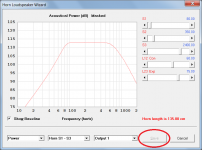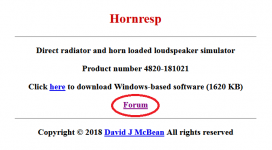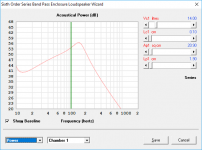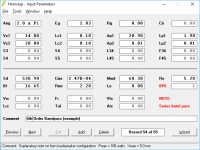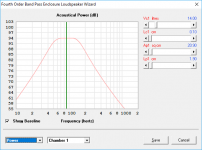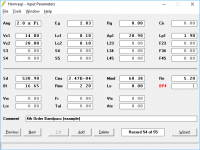Hornresp Update 4820-181021
Hi Everyone,
CHANGE 1
The loudspeaker wizard Save button is now not enabled until a parameter value is changed. Previously the button was always enabled. Post #8738 refers.
CHANGE 2
A link to this diyAudio forum thread has now been added to the Hornresp download webpage.
Kind regards,
David
Hi Everyone,
CHANGE 1
The loudspeaker wizard Save button is now not enabled until a parameter value is changed. Previously the button was always enabled. Post #8738 refers.
CHANGE 2
A link to this diyAudio forum thread has now been added to the Hornresp download webpage.
Kind regards,
David
Attachments
Hi, I have a small suggestion for improving the BP sim component of Hornresp...
When switching from a 4th order BP sim to a 6th order sim (series), it might be best not to switch the Vc1 and Vc2 volumes in the process, i.e. let Vc1 remain the volume that's vented to the outside.
I was doing some "sanity checking" of a design by changing the sim from a 4th order BP to 6th order series tuned BP. If the internal vent is made really small, the response curve should be the same as that predicted by the original 4th order BP sim, but it wasn't when I tried to do that, and I eventually figured out that it wasn't the same because the volumes were being swapped when the type of BP was switched from 4th to 6th .
.
I'm re-writing the entire BP section of my The Subwoofer DIY Page site to focus on the use of Hornresp rather than the old lumped-mass modelling equations, and came across this. I came across a few others as well, which I will document in other messages when I get a chance.
When switching from a 4th order BP sim to a 6th order sim (series), it might be best not to switch the Vc1 and Vc2 volumes in the process, i.e. let Vc1 remain the volume that's vented to the outside.
I was doing some "sanity checking" of a design by changing the sim from a 4th order BP to 6th order series tuned BP. If the internal vent is made really small, the response curve should be the same as that predicted by the original 4th order BP sim, but it wasn't when I tried to do that, and I eventually figured out that it wasn't the same because the volumes were being swapped when the type of BP was switched from 4th to 6th
I'm re-writing the entire BP section of my The Subwoofer DIY Page site to focus on the use of Hornresp rather than the old lumped-mass modelling equations, and came across this. I came across a few others as well, which I will document in other messages when I get a chance.
Attachments
Hi Brian,
The chamber numbering rules I decided upon for the BP4, BP6S, BP6P, BP8, DBR and ABC enclosures (configured as shown in the loudspeaker wizard schematic) are as follows:
For enclosures with left and right chambers (ie. BP4, BP6S, BP6P, BP8):
1 = Left chamber
2 = Right chamber
For enclosures without left and right chambers (ie. DBR, ABC):
1 = Top chamber
2 = Bottom chamber
Letting Vc1 be the volume that vents to the outside could become an issue with BP6P and ABC enclosures, where both chambers have external ports.
I would rather not change from the existing convention. When slider values are changed in the wizard it is always good practice to check with the schematic to confirm what component is being affected. Simply press and hold the S key to temporarily show the schematic.
Even when the chamber volumes are correctly allocated, and the interconnecting port tube is very small, the responses will still be a somewhat different.
You have been busy... .
.
Thanks, your feedback is appreciated.
Kind regards,
David
When switching from a 4th order BP sim to a 6th order sim (series), it might be best not to switch the Vc1 and Vc2 volumes in the process, i.e. let Vc1 remain the volume that's vented to the outside.
The chamber numbering rules I decided upon for the BP4, BP6S, BP6P, BP8, DBR and ABC enclosures (configured as shown in the loudspeaker wizard schematic) are as follows:
For enclosures with left and right chambers (ie. BP4, BP6S, BP6P, BP8):
1 = Left chamber
2 = Right chamber
For enclosures without left and right chambers (ie. DBR, ABC):
1 = Top chamber
2 = Bottom chamber
Letting Vc1 be the volume that vents to the outside could become an issue with BP6P and ABC enclosures, where both chambers have external ports.
I would rather not change from the existing convention. When slider values are changed in the wizard it is always good practice to check with the schematic to confirm what component is being affected. Simply press and hold the S key to temporarily show the schematic.
I was doing some "sanity checking" of a design by changing the sim from a 4th order BP to 6th order series tuned BP. If the internal vent is made really small, the response curve should be the same as that predicted by the original 4th order BP sim, but it wasn't when I tried to do that, and I eventually figured out that it wasn't the same because the volumes were being swapped when the type of BP was switched from 4th to 6th.
Even when the chamber volumes are correctly allocated, and the interconnecting port tube is very small, the responses will still be a somewhat different.
I'm re-writing the entire BP section of my The Subwoofer DIY Page site to focus on the use of Hornresp rather than the old lumped-mass modelling equations, and came across this.
You have been busy...
I came across a few others as well, which I will document in other messages when I get a chance.
Thanks, your feedback is appreciated.
Kind regards,
David
Can the size of the Loudspeaker Wizard dialog window be made the same pixel dimensions as the Horn main program window?
Hi Brian,
The loudspeaker wizard, secondary chart and filter wizard forms are all slightly smaller than the main input parameters form. The only form that is the same size is the Help file form. Technically speaking, the loudspeaker wizard, secondary chart and filter wizard forms are modal, and the Help file form is modeless.
The difference in size was an early carefully considered decision, and is not going to change
Kind regards,
David
For enclosures with left and right chambers (ie. BP4, BP6S, BP6P, BP8):
1 = Left chamber
2 = Right chamber
Yup. The issue is that, when switching from BP4 to BP6P, the chamber that vents to the outside is switched, making it difficult to compare what would happen if a BP4 alignment is converted to a BP6S alignment by adding a vent on the baffle holding the driver (like what KEF did with the last version of their Coupled-Cavity Reference series, if I remember correctly). You have to swap the settings for the volumes around in the sim. This doesn't happen when you switch from BP4 to BP6P, and the "sanity check" works if you do that switch and leave the size of the second vent very small - the predicted frequency response remains very close. See images below:
Image #1: BP4 sim
Image #2: BP4 schematic
Image #3: BP4 response
Image #4: sim converted to from BP4 to BP6P, with very small port for second chamber, no volume changes
Image #5: BP6P schematic (volume initially vented to outside remains the same)
Image #6: BP6P response (basically identical to BP4 response, as expected)
Image #7: sim converted to BP4 BP6S, with very small port for second chamber, no volume changes
Image #8: BP6S schematic (volume that was initially vented to the outside is now closed).
Image #9: BP6S response (significant difference, because now the initial volume that was vented to the outside has been switched when going from BP4 to BP6S. This makes it difficult to switch back and forth between the two for comparison purposes)
Note: addressing this inconsistency could open up the possibility of being able to switch from 4BP to 6BP (P or S) ***inside the wizard itself*** - just by setting the required vent CSA to zero, e.g.
Ap1>0, Ap2=0, Ap12=0 = BP4
Ap1>0, Ap2>0, Ap12=0 = BP6P
Ap1>0, Ap2=0, Ap12>0 = BP6S
Attachments
-
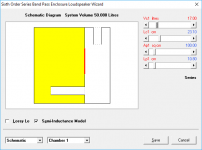 2018-10-22 (12).png11 KB · Views: 54
2018-10-22 (12).png11 KB · Views: 54 -
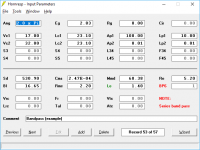 2018-10-22 (11).png15.2 KB · Views: 50
2018-10-22 (11).png15.2 KB · Views: 50 -
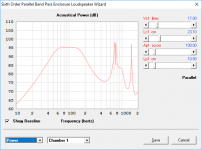 2018-10-22 (10).png21.6 KB · Views: 66
2018-10-22 (10).png21.6 KB · Views: 66 -
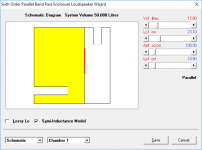 2018-10-22 (9).png11.1 KB · Views: 57
2018-10-22 (9).png11.1 KB · Views: 57 -
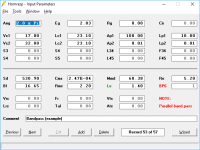 2018-10-22 (8).png15.2 KB · Views: 61
2018-10-22 (8).png15.2 KB · Views: 61 -
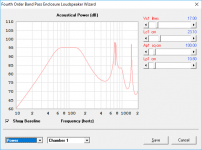 2018-10-22 (6).png21.3 KB · Views: 61
2018-10-22 (6).png21.3 KB · Views: 61 -
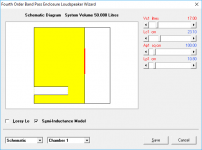 2018-10-22 (5).png10.7 KB · Views: 57
2018-10-22 (5).png10.7 KB · Views: 57 -
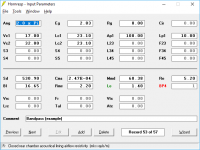 2018-10-22 (3).png15.6 KB · Views: 59
2018-10-22 (3).png15.6 KB · Views: 59 -
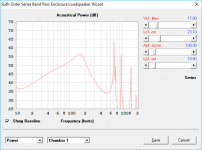 2018-10-22 (13).png21.6 KB · Views: 78
2018-10-22 (13).png21.6 KB · Views: 78
Thawach said...
to which you replied...
So what exactly are you proposing that people should learn how to use a program before they have a need for it? That is a ridiculous idea. We would spend the rest of our lives learning programs we may never need.
It is not practical to learn a program fully before attempting to use it. It is generally by trail an error of a real world application / need that we keep interested enough to develop our skills further.
And the issue is not a willingness to learn the program further, Thawach is saying the program is too difficult to use to further develop skills on it. Some people get it, some don't, but saying try harder is not the answer.
in pa community in thailand. a few times that they learned about hornresp course from paudio in a few meetings. i saw a few people in diy group can use it but they did still not use it good enough. it seems a bit difficult for lot of people
to which you replied...
This is a typical result when one goes into something with the mindset of making something happen rather than learning what the possibilities are.
So what exactly are you proposing that people should learn how to use a program before they have a need for it? That is a ridiculous idea. We would spend the rest of our lives learning programs we may never need.
It is not practical to learn a program fully before attempting to use it. It is generally by trail an error of a real world application / need that we keep interested enough to develop our skills further.
And the issue is not a willingness to learn the program further, Thawach is saying the program is too difficult to use to further develop skills on it. Some people get it, some don't, but saying try harder is not the answer.
Hornresp really isn't that difficult to use. The first thing that needs to be understood is that it's not really the type of speaker-building software where you just chuck in the driver parameters and it will tell you the best size of box and vent to use with the driver. Hornresp is more of an "analysis" type of software where you tell it when you want to sim and it will sim it for you -which means you need to have a fairly good idea of what you want to achieve. This more than anything suggests that it's probably not the best tool for a beginner to use.
The addition of the "Loudspeaker Wizard" component several years ago then allowed the user to take the parameters of the design that they wanted to sim and adjust them easily to achieve their goal (frequency response, power-handling, etc.). But it still remains for the most part what it started out life as, and therefore not the best too for beginners.
The addition of the "Loudspeaker Wizard" component several years ago then allowed the user to take the parameters of the design that they wanted to sim and adjust them easily to achieve their goal (frequency response, power-handling, etc.). But it still remains for the most part what it started out life as, and therefore not the best too for beginners.
I forgot to mention that I'm re-writing significant parts of my website The Subwoofer DIY Page to focus on the use of Hornresp to design sealed, vented, bandpass and transmission line systems, and fairly soon tapped horn and other types of systems will be added as well. My site used to focus on the old "lumped-mass" type of modeling, but I think Hornresp produces more accurate results, particularly now that it includes the "semi-impedance" option. I'm basically "all in", as of this point.
The challenge I'm facing though is that 30% of my site's current visitors are from mobile platforms (hence my question of running Hornresp under Wine 3.0 under Android). Reformatting the content of the site so it's readable on the phone? Sigh...
The challenge I'm facing though is that 30% of my site's current visitors are from mobile platforms (hence my question of running Hornresp under Wine 3.0 under Android). Reformatting the content of the site so it's readable on the phone? Sigh...
Hornresp really isn't that difficult to use. The first thing that needs to be understood is that it's not really the type of speaker-building software where you just chuck in the driver parameters and it will tell you the best size of box and vent to use with the driver. Hornresp is more of an "analysis" type of software where you tell it when you want to sim and it will sim it for you -which means you need to have a fairly good idea of what you want to achieve. This more than anything suggests that it's probably not the best tool for a beginner to use.
The addition of the "Loudspeaker Wizard" component several years ago then allowed the user to take the parameters of the design that they wanted to sim and adjust them easily to achieve their goal (frequency response, power-handling, etc.). But it still remains for the most part what it started out life as, and therefore not the best too for beginners.
Ok understanding that I don't feel so bad about not being able to pick up the ball and run with it then. What software would you suggest for cutting your teeth on to be able to gain sufficient basic knowledge to then come and use Hornsresp?
I forgot to mention that I'm re-writing significant parts of my website The Subwoofer DIY Page to focus on the use of Hornresp to design sealed, vented, bandpass and transmission line systems, and fairly soon tapped horn and other types of systems will be added as well. My site used to focus on the old "lumped-mass" type of modeling, but I think Hornresp produces more accurate results, particularly now that it includes the "semi-impedance" option. I'm basically "all in", as of this point.
The challenge I'm facing though is that 30% of my site's current visitors are from mobile platforms (hence my question of running Hornresp under Wine 3.0 under Android). Reformatting the content of the site so it's readable on the phone? Sigh...
Brian do you know of any good PR modeling software? I am about to build a big PR sub but most software seems to favor the traditional ported / sealed cabinets.
I have read that PRs are more like ported but not exactly the same.
The difference in size was an early carefully considered decision, and is not going to change
Aw shucks. The request was purely based on aesthetics. I'm using screen captures from Hornresp in my site redesign work (e.g. see The Subwoofer DIY Page v1.1 - Sealed Systems for example), and the resulting differently-sized images are driving my OCD crazy, LOL.
I use hornresp for simple PR, 4th order PR, or even 6th parrallel PR (cheating)...If you want something else...Akabak ?Brian do you know of any good PR modeling software? I am about to build a big PR sub but most software seems to favor the traditional ported / sealed cabinets.
I have read that PRs are more like ported but not exactly the same.
I use hornresp for simple PR, 4th order PR, or even 6th parrallel PR (cheating)...If you want something else...Akabak ?
How can you model a PR when there are no "box types" in the software?
simply install a PDF-Creator, which works as a printer device... This way you can make PDFs by simply printing from any windows application... More recent Windows versions have a Microsoft ODF Printer installed. Or try openoffice / libreoffice - which has build in PDF Export.
The times where you have to spend a lot of money buying microsoft acrobat to get a PDF are over for at least a decade, its very simple nowadays.
Thanks! No ODF printer installed. I have MS Office, just not installed yet. I found out that the Foxit version I have will make pdfs once it's installed, which I assume has this ODF printer.
GM
How can you model a PR when there are no "box types" in the software?
???? HELP/INPUT WIZARD/choose space/Direct radiator/Passive radiator/'confirm'/Finish
Now you have a PR master to either modify or save, then copy to modify.
Before this recent addition one had to calculate the air mass required to get the desired tuning, then convert it into a vent length [Lpt] with a vent area [Ap] = to the desired PR's Sd. This of course can be done with any vented math/software once the vent dimensions have been calculated.
GM
Brian do you know of any good PR modeling software? I am about to build a big PR sub but most software seems to favor the traditional ported / sealed cabinets.
I have read that PRs are more like ported but not exactly the same.
Hopefully, my posting how we use to calculate them explains the difference [not much].
Unibox was once very popular and may still be in some circles: UniBox - Unified Box Model for Loudspeaker Design - Kristian Ougaard
GM
- Home
- Loudspeakers
- Subwoofers
- Hornresp
